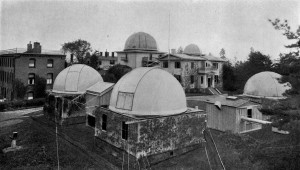After reading my last post on Harvard Observatory, my partner gave me a follow-up birthday present, The Harvard College Observatory: The First Four Directorships, 1839-1919, by Bessie Zaban Jones and Lyle Gifford Boyd (1971). It covers a time period slightly too early to include Jenka Mohr’s most active years at the observatory, but it does include a photo of December 31, 1929, performance of “The Observatory Pinafore,” for which she played the violin. Notice the fantastic image of Saturn on the back wall:

Harvard Pinafore, December 31, 1929. L to R: "Prof. Rogers" (Percy M. Milliman); "Josephine" (Cecila H. Payne): "Lady computers" (Henrietta Swope, Mildred Shapley, Helen B. Sawyer, Sylvia Mussels, Adelaide Ames); "Prof. Searle" (Leon Campbell, Sr. )
At any rate, I’m slowly making my way through the book. First, I had to study the 57 illustrations. After that, I skimmed Chapter XI, “A Field for Women,” hoping to find some trace of Mohr’s earliest days at the observatory (her name wasn’t mentioned). Now I’m starting from the beginning, Chapter I, “Before the Observatory.”
I mention this because this chapter brought me to an intellectual halt on its first page. My own research focuses on the eighteenth century and really has nothing to do with American observatories—my last two projects dealt with India and England, with occasional forays into France, Austria, Bavaria and Portugal. Which is to say, I don’t spend a lot of time thinking about the direction taken by American astronomy during the seventeenth century. Honestly, it never occurred to me that there was a point at which the American astronomy curriculum switched from a Ptolemaic worldview to a Copernican. In my mind, that was something that happened in Europe (and for my work, India), well before a firm university tradition was established in North America.
But as early as 1642, the “Laws, Liberties and Orders of Harvard College” were offering astronomy as part of the curriculum. By 1659, Harvard was leaning fairly strongly toward the Copernican system, as evidenced by the explanation of it in the New England Almanac, written by the Harvard graduate, Zechariah Brigden. Spending so much intellectual time in the Euro-Asian eighteenth century has caused me not only to forget how early Harvard was established (1636), but also that, despite a decided emphasis on Puritan learning and ideals, it had strong ties to Cambridge University and its tradition of scientific education.
And speaking of Copernicus, I have just started reading an advance copy of Dava Sobel’s A More Perfect Heaven: How Copernicus Revolutionized the Cosmos (out next month in the U.S.). I’ll let you know my take on the embedded play after I finish the book.
